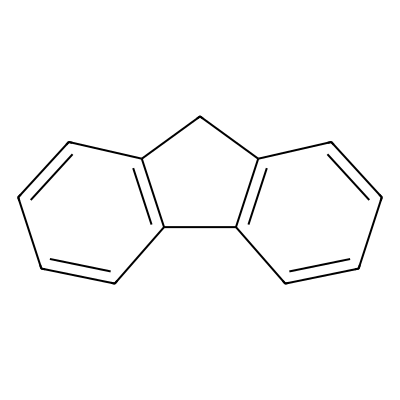
Fluorene
| ToxCast Endpoints |
|---|
ToxCast Endpoints for intended target type: RNA
| Assay Name | Tissue | Target Gene ID | Target HGNC Symbol | Target UniProt ID | Response | AC50 value |
|---|---|---|---|---|---|---|
| LTEA_HepaRG_CYP1A1 | Liver | 1543 | CYP1A1 | P04798 | Activatory | 50.00 μM |
| LTEA_HepaRG_CYP2B6 | Liver | 1555 | CYP2B6 | P20813 | Activatory | 31.86 μM |
ToxCast Endpoints for intended target type: Protein
| Assay Name | Tissue | Target Gene ID | Target HGNC Symbol | Target UniProt ID | Response | AC50 value |
|---|---|---|---|---|---|---|
| ATG_ERE_CIS | Liver | 2099 | ESR1 | P03372 | Activatory | 100.00 μM |
| ATG_PXRE_CIS | Liver | 8856 | NR1I2 | O75469 | Activatory | 72.40 μM |
| ATG_ERa_TRANS | Liver | 2099 | ESR1 | P03372 | Gain | 35.38 μM |
| ATG_RXRb_TRANS | Liver | 6257 | RXRB | P28702 | Gain | 61.71 μM |
| BSK_3C_TissueFactor | Vascular | 2152 | F3 | P13726 | Inhibitory | 4.37 μM |
| TOX21_p450_CYP1A2_Antagonist | 1544 | CYP1A2 | P05177 | Loss | 10.19 μM | |
| TOX21_p450_CYP2C9_Antagonist | 1559 | CYP2C9 | P11712 | Loss | 27.99 μM | |
| TOX21_p450_CYP1A2_Antagonist | 1544 | CYP1A2 | P05177 | Loss | 10.11 μM |
No ToxCast endpoints for intended target type: Molecular Messengers
ToxCast Endpoints for intended target type: Pathway
| Assay Name | Tissue | Target Gene ID | Target HGNC Symbol | Target UniProt ID | Response | AC50 value |
|---|---|---|---|---|---|---|
| TOX21_ARE_BLA_Agonist_ratio | Liver | 4780 | NFE2L2 | Q16236 | Gain | 71.41 μM |
| TOX21_p53_BLA_p5_ch2 | Intestinal | Gain | 86.48 μM | |||
| TOX21_p53_BLA_p5_ratio | Intestinal | 7157 | TP53 | P04637 | Gain | 87.29 μM |
ToxCast Endpoints for intended target type: Cellular
| Assay Name | Tissue | Response | AC50 value |
|---|---|---|---|
| TOX21_RT_HEK293_FLO_24hr_viability | Kidney | Gain | 31.73 μM |
| TOX21_RT_HEK293_FLO_32hr_viability | Kidney | Gain | 38.80 μM |
| TOX21_RT_HEK293_FLO_40hr_viability | Kidney | Gain | 38.80 μM |
| TOX21_RT_HEK293_FLO_40hr_viability | Kidney | Gain | 54.48 μM |
ToxCast Endpoints for intended target type: Extracellular
| Assay Name | Tissue | Response | AC50 value |
|---|---|---|---|
| TAMU_PeakParms_SingleDonor1434_Chronotropy | Heart | Inhibitory | 50.00 μM |
DISCLAIMER
TICToK is a database of tattoo ink chemicals compiled from different regulatory resources. The authors are not liable for any inaccuracies or omissions of any chemicals in this resource. Importantly, our sole goal to build this resource on tattoo ink chemicals is to enable future basic research on this topic, and it does not necessarily reflect the views or objectives of our employers or funders.